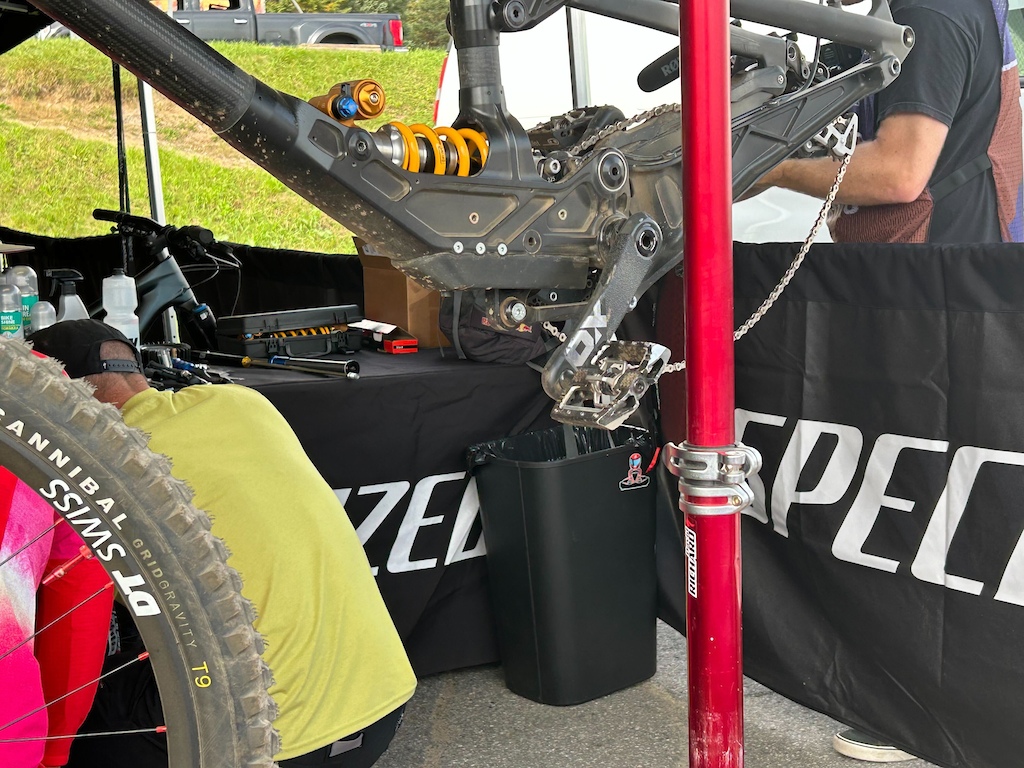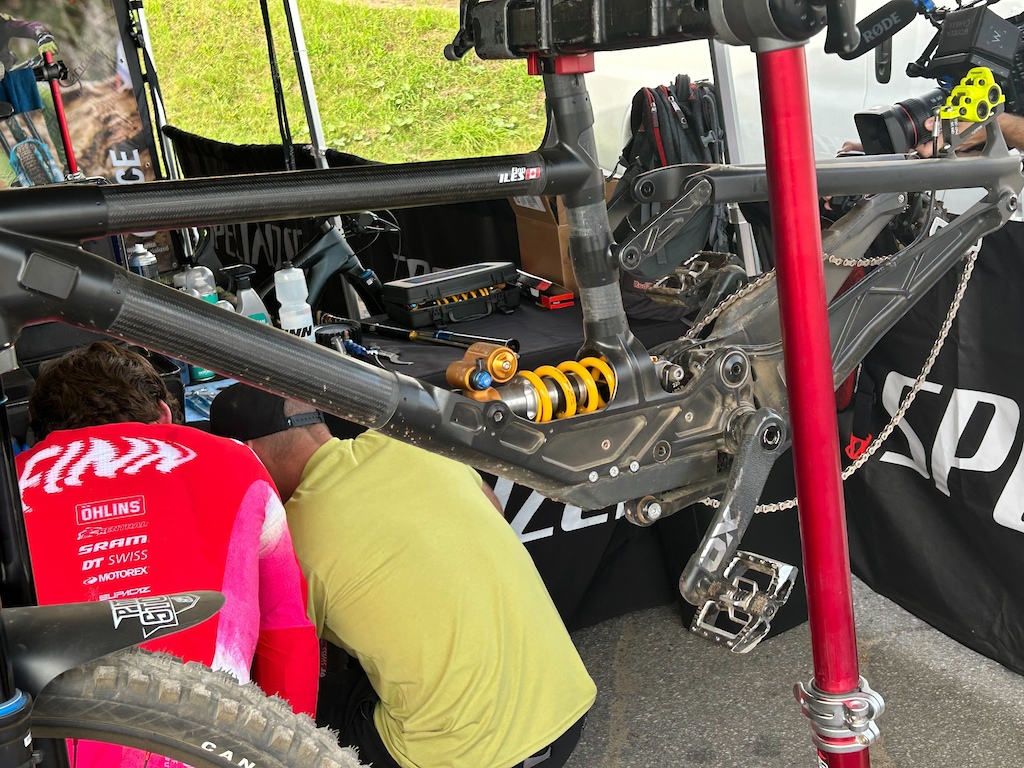Spotted: Under the Cover of Specialized's Prototype Downhill Bike
Rumors and theories have circulated amongst the tech keeners about what lay underneath the covers on Specialized's prototype downhill bike for over a year now, but these new photos of Finn Illes' bike in the workstand give a better understanding of the suspension system.
From the visible portions of the frame, only so many possibilities existed given the short link at the top of the seatstay (which looks to be from Specialized's Enduro model) and dropout pivot. The use of a Horst Link was clear, but the cover hid the main pivot location, pull-rod and rocker link that's now visible.
The CNC'd alloy chainstay truss rotates on a massive main pivot near the top of the chainring, pulling on the rod under the bottom bracket, rotating the rocker link around the black bolt in the CNC'd shock basement, rearward of the three smaller silver bolts. This suspension layout isn't a new concept - Ancillotti Cycles have been using a non-Horst link version for years. On a downhill bike, the ability to keep the bike's weight as low and centered as possible is likely one of the main benefits.
It's likely that the axle path is typical of a Horst Link, which is nearly vertical, but moves slightly rearward, then forward significantly.
Further tuning could be easily accomplished by swapping the rocker link or even tweaking the geometry by altering the pull-rod length. On the rocker near the lower shock mount, the number "225" is visible, implying that different shock lengths and travel amounts are being tested.
Loic Bruni has been riding a very similar bike to the one seen here, although there could be more at play there in terms of damping controls since we've seen electronic buttons mounted to his handlebar.
When asked, Specialized remained tight lipped about the frame details and its future, but did say where the frame was made and provided a name for the suspension type; "Under Bottom Bracket" or "UBB".
Here's their official statement on what they have dubbed as "Project Black".
Author Info:
Must Read This Week
Sign Up for the Pinkbike Newsletter - All the Biggest, Most Interesting Stories in your Inbox
PB Newsletter Signup




m.pinkbike.com/forum/listcomments/?threadid=245795
That boot they’ve been using has been doing more than hide this resurrection of the 1993 version.
My take, anyway.
aesthetics are of course subjective, but i think this bike looks badass. would love to see this platform make it's way to the enduro (in a refined iteration).
Evil's DELTA system is just as complicated as Saracen if you want to compare another single pivot.
I'm not sure why anyone thinks a link driven single pivot or split pivot is a bad thing. To all you armchair engineers crying "OMG IT SUX, ITS SINGLE PIVOT" can I remind you that some of the biggest teams with the most wins ran and still run single/split pivot. Trek and Devinci to name two very big and obvious ones.
Both of the "obvious ones" you pointed out are split pivot designs.
I feel like most people's objection to single pivot is that the axle path rotates around a fixed point, in which case split pivot IS a single pivot layout.
And this sort of exemplifies my point - most of the people complaining about it don't actually understand it well enough to form a well informed opinion.
Let's also not forget that most of the 'on trend' high pivot designs are a single pivot layout. Forbidden, Deviate etc.
Not that there's anything single-pivot about this Specialized design. The axle is not attached to the swingarm; it is controlled via a linkage. It's a four-bar system with separate linkages for the wheel and for the shock. The addition of the shock link does not make it a six-bar, as some have said above: "X-bar" refers to the elements that dictate the movement of the rear wheel. Designers can add a separate linkage for the shock, a floating brake, etc., but those don't change the elements moving the rear wheel and, therefore, don't change the linkage classification.
I'm very aware of that, I was addressing the folks in the room complaining about all the "complicated" looking pivots on the single-pivot Saracen bike.
I prefer to describe it as a Horst four-bar with zero offset at the chainstay pivot, but some folks have trouble getting their heads around that; if people prefer to call it a single-pivot with a floating brake, that's fine, but it's important to note the equivalence of these concepts in the case of a Split Pivot configuration when the brake is not attached to the chainstay.
The vertical link dropping down from the middle of primary link made me think it was a six-bar when I first saw it, like the old Felt Equilink and the new Commencal Supreme v5. More links aren't necessarily better, but it's fun when bike companies get weird, so it was disappointing to find out the Saracen was less exotic.
I suspect we'll see more and more high pivot designs combined with split pivot/4-bar/6-bar designs.
Describing a bike as hand crafted is weird marketing because technically all bikes are ‘handcrafted’ except the parts that are milled, forged, extruded etc.
Hope its sturdy on the production model.
but there are many other mountain bike websites out in the world wide web....
For your viewing pleasure
www.vitalmtb.com/forums/The-Hub,2/2020-MTB-Tech-rumors-and-innovation,10797?page=465
Specialized persisted with lower than average anti-squat until the 2019 Enduro revision, at which point they leapt to values well above average. Nothing about these properties are intrinsic to the Horst configuration; they're just choices made by the designers.
Similarly, most Specialized designs used high leverage ratios with light damper tunes, giving a "plush" feel. Again, just design choices.
Several years ago, Knolly and Whyte had half the anti-squat of the Enduro - and the Privateer 161 and Orbea Rallon had even higher anti-squat values. All Horsts (with an extra shock link, in Knolly's case), but at opposite ends of the spectrum. A Gamux Runi had a 50% higher leverage ratio than a Bird Aeris 145 - again, both Horsts, and both at opposite ends of the spectrum.
It's not which type of four-bar link that determines the ride characteristics, it's how the designer(s) choose to configure it.
I had a 2015-ish Enduro 29 and it pedaled incredibly well with the stock shock.
My current Bird Aeris 9 seems to combine high-ish anti-squat with low leverage rate to get decent pedaling and good bump absorbtion - but only if used with a low compression tune shock.
Then the rearward/forward info tells us how it moves -slightly- horizontally during compression.
But yeah the rest is confusing at best, stating that Horst is the reason for this? There's no direct link between the 2
Meanwhile, lower antisquat and reasonably low antirise will typically mean that a bike will have a plush and active suspension when descending, with less chain growth, pedal kickback and remain active under braking.
Yes, high pedaling anti-squat is usually associated with a firm (not "squishy") pedaling response, but it can be complicated. Extremely high pedaling anti-squat - we're talking about a level not seen since the bad old days of suspension - can cause "inchworming", where the suspension jacks due to chain tension and can be extremely inefficient. There's also a region of moderately low pedaling anti-squat that can set up a resonant bobbing with the rider's vertical torso and leg movements, producing a lot of bike movement; a bike with less pedaling anti-squat would be more stable, though also more "squishy" under power. Finally, for a direct drivetrain (no idler or equivalent), more pedaling anti-squat results in more pedal feedback while pedaling ("kickback", though the cranks don't actually counter-rotate).
Leverage rate and bump absorption is a tricky relationship. You're correct that a low leverage ratio should be matched to a lighter damping tune, and vice-versa. Some dampers still choke (feel harsh) at some shaft speeds and the higher speeds of a low leverage bike is more likely to expose these sub-optimal damper properties. A design with a high leverage ratio can hide some damper shortcomings, while introducing other potential problems.
There isn't enough time or mental bandwidth in downhill to have a system with complex manual inputs. The most a rider could realistically manage would be a short-throw dial, such as a Grip Shift, but even that would be a stretch. A binary-state, on/off system is more realistic - and even that might have a timer that defaults to the "rowdy terrain" setting if the rider accidentally actuates the "easy terrain" mode or fails to switch back when things get busy.
I'm not involved with the Specialized Gravity + Öhlins project, so I can only speculate on Bruni's system. Some guesses at what the modes might be:
1. Steep and not-so-steep.
- Steep: Firmer front spring and softer rear. Firmer compression and faster rebound damping on the front and vice-versa on the rear.
- Not-so-steep: Inverse.
2. Fast and slow.
- Fast: Lighter damping, especially low-speed.
- Slow: Inverse.
3. More support and less support.
- More: Firmer spring and damping for increased control.
- Less: Softer spring and less damping for less fatigue on the body and faster rolling.
4. Electronic system on and off. This could be anything from the pantheon of gadgets already on the market (SRAM Flight Attendant, Fox Live Valve, Lapierre E:i, Noleen/K2 Smart Shock) to a proper active system with GPS or terrain scanning (unlikely, but fun to hope).
These changes could act on the linkage via moveable mounting points, the springs, and/or the dampers. Damper adjustments are most likely, but it would be exciting if all three were in play.
That rear wheel moves crazy fast,the suspension and bike combo is fine tuned every race to almost perfection.
They make a great job for those riders,at least we can see the bike is more planted/stable.
Bruni's bike, in particular, appears to use less spring support and more damper support (lower ride height, yet doesn't blow through the travel). There have been some anecdotes from interviews with Öhlins staff that indicate Bruni's compression damper support a few years ago was roughly four times firmer than what's used on their consumer products; haven't heard any updates since then, but it still appears to sit low without using excessive travel.
Except, even saying "typical horst-link" is just stupid, because there are _so_ many options for pivot placements and link lengths and thus axle path... it's kind of the whole point of any multi-link system..
The key is not the independence... The last two production Demos could do that. Especially the last one with the Sender/Enduro/moto style linkage. This one might be a bit easier to mess with leverage ratios since that linkage is outside the constraints of having to fit inside the whole getup.
The weight is also concentrated far down, so not a bad design at all.
This new bike still uses 148x12 rear axle and no chainstay flip chip,it looks like quite simple from the outside,nothing too fancy.
1 piece chainstay bike:
www.mbr.co.uk/reviews/full-suspension-bikes/arbr-rb2-first-ride-f1-knowledge-wrapped-up-in-a-unique-full-suspension-package
The new demo has a bearing in the chainstay like @Bird-in-dirt remarked,so the chainstays additional forces in this design are those going to the linkages and shock.
If not,you do not need a seatstay to build a bike like you describe. Compared to an actual Demo got less complicated pieces,more elegant solution and I bet 100% more stiffer rear end cos the way all attach together.
It's unclear whether the seatstay linkage will add stiffness. It will, if compared to the same chainstay without the seatstay linkage, but it's impossible to know which system is stiffer simply based on the presence or absence of the seatstay linkage. An important difference is that the ARBR chainstay uses a hollow cross-section, while the Specialized uses an open cross-section.
Probably with E motors because marketing
Create something of your own Specialized!
This novel linkage system enables us to independently fine-tune key ride dynamics components, including axle path, shock leverage rate, and anti-squat/anti-rise characteristics for braking.
Show us Bruni's
Copy/paste:
1989 was the year that carbon fiber road bikes became available to the masses. Specialized had the Allez Epic, Trek made the 2100 and Giant made the Cadex. Our friend Fred Williams walked into Mercer Island cycles in 1989 and rolled out with this Giant. He got quite a deal.
For around $1200, Fred got a pretty light and cool looking road bike with a Shimano 105 component group, a Vetta gel saddle, Look pedals and an Avocet 40 bike computer.
The carbon construction method for these early bikes was pretty straight forward. Cut, mold and cure carbon fabric into round tubes.
Cut the tubing into the correct lengths and glue them in a tube-and-socket fashion into aluminum lugs (that you probably already had ready to go for your all-aluminum bikes). Clean and sand the excess glue, add a clear coat finish (by the way, you don’t want to cover the carbon with colored paint, people have to see the carbon weave) and you’re done!
But then what would they know about guns..